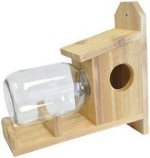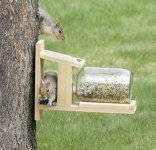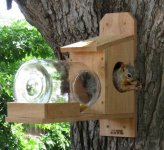Инструкция по изготовлению кормушки для белок, которая защищена от ворон и голубей
Текст на английском, а измерения в дюймах и футах, но при нынешних технологиях не трудно перевести на русский плюс отправные моменты конструкции и без текста ясны.




Here’s What You’ll Need…
• One 6-foot 1-inch x 6-inch “dog-eared” cedar fence board
• 2-1/2-inch and 1-5/8-inch galvanized deck screws
• One 1-gallon glass jar
Recommended Tools…
• Saber saw
• Compass
• Rasp or rough sandpaper

1. Cut the pieces from a 6-foot 1-inch x 6-inch fence board according to the board layout at left.
2. Make the jar support (F) by tracing the curve of the jar onto the wood. The lowest point of the curve should be 1 inch from the bottom of the board.
Cut along the line with a saber saw. Place the jar on the support to check that it fits well. Trim the sharp corners off the support (about 1/4 to 1/2 inch) and smooth rough edges with sandpaper.
The curved piece remaining from this will become the end piece (G).
3. Cut entrance holes in both side pieces. Mark a spot about 3-1/2 inches from the highest corner of each board and center the hole from side to side. Draw a 3-inch-diameter circle with a compass, then cut out the holes with a saber saw. Smooth rough edges with sandpaper.
4. Make a hole in the front of the feeder to hold the neck of the jar. This is a tricky step because jars vary in size. Start by determining the radius of the jar’s mouth. Then lay the jar on its side and measure from the tabletop to the bottom of the mouth. Add these two measurements plus 1 inch. Mark this distance from the bottom of the front board and center.
From this point, draw a circle 1/2 inch larger than the diameter of the mouth. Cut the hole with a saber saw.
5. Assemble the front and sides of the squirrel feeder, then attach the assembled pieces to the base. These joints, and all others, will be fastened with 1-5/8-inch galvanized deck screws. Cedar splits easily, so be sure to drill pilot holes in each piece before driving in the screws.
6. Attach the jar support about 3 inches from the far end of the base. Then position the rounded end piece—which keeps the jar from sliding out of the feeder—at the edge of the base. However, make sure there is enough clearance for you to tip the jar out for filling. If it’s too tight, use a rasp to round the inside curved edge of this end piece until the jar can easily be removed. If the jar is too loose, move the rounded end farther up the base before attaching it.
7. Predrill holes in the mounting board, then attach it to the feeder with 1-5/8-inch deck screws.
8. If you’d like to make a beveled edge on the roof piece so it tightly meets the mounting board, cut a 15° angle on the back edge with a table saw. Attach the roof to the sides using 1-5/8-inch deck screws.
9. Mount the feeder on a tree with 2-1/2-inch deck screws (this is a heavy feeder—you’ll need large screws to mount it securely) and fill it with nuts in the shell. Then check your watch. It won’t be long before you’ll be inviting the neighbors over to admire your “squirrel under glass”!

Note: All board widths are 5-1/2 inches. The length of the base will vary with the length of the jar.
Текст на английском, а измерения в дюймах и футах, но при нынешних технологиях не трудно перевести на русский плюс отправные моменты конструкции и без текста ясны.




Here’s What You’ll Need…
• One 6-foot 1-inch x 6-inch “dog-eared” cedar fence board
• 2-1/2-inch and 1-5/8-inch galvanized deck screws
• One 1-gallon glass jar
Recommended Tools…
• Saber saw
• Compass
• Rasp or rough sandpaper

1. Cut the pieces from a 6-foot 1-inch x 6-inch fence board according to the board layout at left.
2. Make the jar support (F) by tracing the curve of the jar onto the wood. The lowest point of the curve should be 1 inch from the bottom of the board.
Cut along the line with a saber saw. Place the jar on the support to check that it fits well. Trim the sharp corners off the support (about 1/4 to 1/2 inch) and smooth rough edges with sandpaper.
The curved piece remaining from this will become the end piece (G).
3. Cut entrance holes in both side pieces. Mark a spot about 3-1/2 inches from the highest corner of each board and center the hole from side to side. Draw a 3-inch-diameter circle with a compass, then cut out the holes with a saber saw. Smooth rough edges with sandpaper.
4. Make a hole in the front of the feeder to hold the neck of the jar. This is a tricky step because jars vary in size. Start by determining the radius of the jar’s mouth. Then lay the jar on its side and measure from the tabletop to the bottom of the mouth. Add these two measurements plus 1 inch. Mark this distance from the bottom of the front board and center.
From this point, draw a circle 1/2 inch larger than the diameter of the mouth. Cut the hole with a saber saw.
5. Assemble the front and sides of the squirrel feeder, then attach the assembled pieces to the base. These joints, and all others, will be fastened with 1-5/8-inch galvanized deck screws. Cedar splits easily, so be sure to drill pilot holes in each piece before driving in the screws.
6. Attach the jar support about 3 inches from the far end of the base. Then position the rounded end piece—which keeps the jar from sliding out of the feeder—at the edge of the base. However, make sure there is enough clearance for you to tip the jar out for filling. If it’s too tight, use a rasp to round the inside curved edge of this end piece until the jar can easily be removed. If the jar is too loose, move the rounded end farther up the base before attaching it.
7. Predrill holes in the mounting board, then attach it to the feeder with 1-5/8-inch deck screws.
8. If you’d like to make a beveled edge on the roof piece so it tightly meets the mounting board, cut a 15° angle on the back edge with a table saw. Attach the roof to the sides using 1-5/8-inch deck screws.
9. Mount the feeder on a tree with 2-1/2-inch deck screws (this is a heavy feeder—you’ll need large screws to mount it securely) and fill it with nuts in the shell. Then check your watch. It won’t be long before you’ll be inviting the neighbors over to admire your “squirrel under glass”!

Note: All board widths are 5-1/2 inches. The length of the base will vary with the length of the jar.
